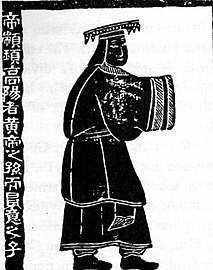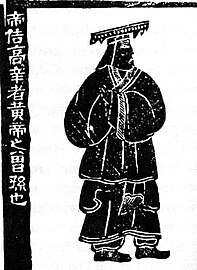| Revision as of 04:09, 22 June 2006 editAish Warya (talk | contribs)94 edits only mainland, not all of China← Previous edit | Latest revision as of 12:38, 8 January 2025 edit undoMorris80315436 (talk | contribs)Extended confirmed users, Pending changes reviewers1,370 edits →Origin and history: red link removalTag: 2017 wikitext editor | ||
| Line 1: | Line 1: | ||
| {{Short description|none}} | |||
| The '''] of ]''' or '''''Huángdì''''' (皇帝) was the ] and ] of ] from the ] in ] until the fall of the ] in ], with brief interruptions in 1915 and 1917. The pre-Qin heads of the government were called '']'' (roughly translated as ''King''). Before the first Emperor of China, ], the characters ''Huang'' ("godking") and ''Di'' ("sage king") were used separately and never consecutively (See ]). After the ], ''Huangdi'' began to be ]d to ''Huang'' or ''Di''—the two characters had lost their original pre-Qin meanings. | |||
| {{Overillustrated}} | |||
| {{About||the volcano in Indonesia|Emperor of China (volcano)}} | |||
| {{pp-move}} | |||
| {{Use American English|date=March 2024}} | |||
| {{Infobox former monarchy | |||
| | royal_title = Emperor | |||
| | native_name = {{langn|zh|皇帝}} | |||
| | coatofarms = File:Inscription on Imperial Seal of China "受命於天 既壽永昌".svg | |||
| | coatofarmssize = 120px | |||
| | coatofarmscaption= ] | |||
| | image = Qinshihuang.jpg | |||
| | image_size = 230px | |||
| | caption = ], the first emperor of China {{nowrap|({{r.}}221–210 BC).<ref>{{Cite book |editor1-last=Dillon |editor1-first=Michael |title=Encyclopedia of Chinese History |date=2017 |publisher=Routledge |isbn=978-0-415-42699-2 |page=182}}</ref>}} Mid 19th century depiction | |||
| | realm = China | |||
| | border = imperial | |||
| | first_monarch = ] | |||
| | last_monarch = ] | |||
| | style = His ] {{nwr|({{zhi|c=陛下|p=Bìxià}})}} | |||
| | began = 221 BC {{nwr|({{age|-221}} years ago)}} | |||
| | ended = 12 February 1912 {{nwr|({{age|1912|02|12}} years ago)}}{{refn|group=n|] was installed as Emperor in the short-lived ] in December 1915, but abdicated after 83 days. Puyi was reinstated as Emperor for 12 days in 1917 in a ].<ref>{{cite web |url=https://www.scmp.com/magazines/post-magazine/short-reads/article/3203233/german-princes-coup-attempt-recalls-chinas-last-emperor-aisin-gioro-puyi-who-was-reinstated-and |title=German prince’s coup attempt recalls China’s last emperor Aisin-Gioro Puyi, who was reinstated and removed, twice |publisher=] |access-date=19 September 2024}}</ref><ref name="shikai">{{cite web |url=https://thechinaproject.com/2020/12/09/the-legacy-of-yuan-shikai-chinas-disastrous-first-president/ |title=The legacy of Yuan Shikai, China’s disastrous first president |publisher=China Project |access-date=19 September 2024}}</ref>}} | |||
| }} | |||
| Throughout ], "]" ({{zh|c=皇帝|p=Huángdì}}) was the superlative title held by the ] who ruled various imperial ] or ]. In traditional Chinese political theory, the emperor was the "]", an ] with the ] right to rule ]. Emperors were worshiped posthumously under an ]. The lineage of emperors descended from a paternal family line constituted a ], and ] in most cases theoretically followed ]. The emperor of China was an ]. | |||
| ==Position and power== | |||
| Since the Qin Dynasty, the Emperor of China has been formally styled the ] (天子), and as the descendant and representative of heaven on earth, legally has the absolute power over all matters, big or small, under heaven. The Emperor's words and directives are considered ]s (聖旨). In theory, the Emperor's orders are followed with immediate obedience. He is elevated above all commoners, nobility, and members of the imperial family. Address to the Emperor is always to be formal and self-deprecatory, often even with the closest of family members. | |||
| During the ], ] gained sanction as the official political theory. The absolute authority of the emperor came with a variety of governing duties and moral obligations; failure to uphold these was thought to remove the dynasty's ] and to justify its overthrow. In practice, emperors sometimes avoided the strict rules of succession and dynasties' purported "failures" were detailed in ] written by their successful replacements or even later dynasties. The power of the emperor was also limited by the ], which was staffed by ], and ] during some dynasties. An emperor was also constrained by ] to his ancestors' policies and dynastic traditions, such as those first detailed in the ] '']'' (''Ancestral Instructions''). | |||
| In practice, however, the power of the Emperor varied between different Emperors and different ]. Many Emperors ruled as ]s with an iron fist on the country. A prominent example is ], the first ''Emperor of China''. Other Emperors, however, have found the ], court officials, ]s, and nobility taking over actual power (ex. ] of the ], ] of the ]). | |||
| == |
== Origin and history == | ||
| {{See also|Chinese sovereign}} | |||
| The title of Emperor was transmitted from father to son. By convention in most ]-ruled dynasties, the eldest son born to the ] (嫡長子) succeeds the throne. In some cases when the Empress did not bear any children, she could adopt a son as her own and the son is subsequently made heir (although all children of the Emperor are said to also be the children of the Empress, regardless of birth mother). In some dynasties the succession of the Empress's eldest son was disputed, and because many Emperors had large numbers of progeny, often led to wars of succession between rival sons. In attempts to resolve disputes after death, the Emperor often designated a ] (太子) in early times. Even such a clear designation, however, caused problems within the imperial family involving jealousy and distrust, whether it was the Crown Prince plotting against the Emperor, or brothers plotting against each other, and further does not actually ensure a peaceful succession. Some Emperors, like the ], after abolishing the position of Crown Prince, placed the succession papers in a sealed box, only to be opened and announced after his death. | |||
| ] escaping assassination (3rd century AD)]] | |||
| {{multiple images|perrow=1 | |||
| |image1= Pre-Qing Ancient Imperial Chinese Banner.webp| | |||
| |image2= Imperial Encyclopaedia - Military Administration - pic155 - 太常圖.svg | |||
| |footer=The Great Chang banner (大常/太常), also known as Banner of Celestial Bodies (辰旒), the highest ranking banner reserved for monarchs per ].<ref>{{cite |title= 通典 |chapter=25|url=https://zh.wikisource.org/%E9%80%9A%E5%85%B8/%E5%8D%B7025|quote=顏師古曰:「太常者,王之旌也,畫日月焉。王者有大事則建以行,禮官主奉持之,故曰奉常,後改為太,尊大之義也。」}}</ref><ref>{{cite |title= 周禮 |chapter=春官宗伯—司常之職|url=https://zh.wikisource.org/%E5%91%A8%E7%A6%AE/%E6%98%A5%E5%AE%98%E5%AE%97%E4%BC%AF|quote=旗物:王建大常,諸侯建旗,孤卿建旃,大夫、士建物,師都建旗,州里建旟,縣鄙建旐,道車載旞,斿車載旌。」}}</ref>}} | |||
| During the ] dynasty ({{c.|1046 BC}}{{snd}}771 BC), Chinese ] with power over their ] served a strong central monarch. Following a brutal succession crisis and relocation of the royal capital, the power of the ] ({{zhi|c=王|p=wáng}}{{efn|{{Old Chinese|ɢʷaŋ}},<ref name="baxsag">Baxter, William & al. '' {{webarchive |url=https://web.archive.org/web/20130927141238/http://crlao.ehess.fr/docannexe.php?id=1207 |date=September 27, 2013 }}''. 2011. Accessed 22 Dec 2013.</ref>}}) waned, and during the ] period, the regional lords overshadowed the king and began to usurp that title for themselves. In 221 BC, after the King of ] completed the conquest of the various kingdoms of the ], he adopted a new title to reflect his prestige as a ruler greater than the rulers before him. He called himself "Shi Huangdi", or the 'First Emperor'. Before this, ''Huang'' ({{lang|lzh|皇}} 'august', 'sovereign'{{efn|{{Old Chinese|ɢʷˤaŋ}}}}) was most commonly seen as a reverential epithet for a deceased ancestor, and ''Di'' ({{lang|zh|帝}}, {{Old Chinese|tˤeks|show_lang=yes}}) was an apical ancestor, originally referring to ] of the ] kings.<ref name=wibla/>{{efn|''Huang'' ({{lang|zh|皇}}) and ''Di'' ({{lang|zh|帝}}) were also terms applied to the ], mythical godly rulers and culture heroes credited with feats like ordering the ] and forming the first humans out of clay, as well as the invention of agriculture, ], ], ], etc.}} In the 3rd century BC, the two titles had not previously been used together. The emperor of China, like the Zhou kings before him, and the Shang kings before them, was most commonly referred to as ''Tianzi'' ({{lang|zh|天子}} 'Son of Heaven'), who was ] to rule. The appellation ''Huangdi'' carried similar shades of meaning.<ref>{{Cite book |last1=Harrison |first1=Thomas |title=The Great Empires of the Ancient World |last2=Blanshard |first2=Alastair |last3=Bryce |first3=Trevor |last4=Coningham |first4=Robin |last5=Jenner |first5=W. J. F. |last6=Kaizer |first6=Ted |last7=Llewellen-Jones |first7=Lloyd |last8=Manley |first8=Bill |last9=Manuel |first9=Mark |publisher=] |year=2009 |isbn=978-0-89236-987-4 |editor-last=Harrison |editor-first=Thomas |location=Los Angeles |page=254 |author-link3=Trevor R. Bryce |author-link4=Robin Coningham |author-link7=Lloyd Llewellyn-Jones}}</ref> Alternate English translations of the word include "The August Ancestor", "The Holy Ruler", or "The Divine Lord". On that account, some modern scholars translate the title as "]".<ref name="wibla">Nadeau, Randall L. ''The Wiley-Blackwell Companion to Chinese Religions'', John Wiley & Sons (Chichester), 2012. Accessed 22 December 2013.</ref> | |||
| On occasion, the father of the ascended emperor was still alive. Such an emperor was titled as the ] ('grand imperial sire'). The practice was initiated by Qin Shi Huang, who gave the title as a ] to his own father, as was already common for monarchs of any stratum of power. ], who established the ], was the first to become emperor while his father yet lived. It was said he granted the title during his father's life because he would not be done obeisance to by his own father, a commoner.<ref>Sima Qian, ''Records of the Grand Historian'', "Gaozu's Basic Annals", </ref><ref>Sima Qian (author) & Burton Watson (translator) (1971). ''Records of the Grand Historian of China'' "Volume I: The Early Years of the Han dynasty from 209 to 141 B.C. Part III: The Victor - The Basic Annals of Emperor Kao-tsu (Shih-chi 8)" p. 108-109.</ref> | |||
| Unlike the ], Chinese political theory (See ]) allowed for a change in Dynasty and an Emperor could be replaced by a rebel leader. Prominent examples include the first Ming Emperor ] (Hongwu Era), and ], leader of the ], who ruled with the title '']''. As the Emperor usually has a large number of sons, it was generally not possible for a female to succeed to the throne. In the history of China there has only been one lawful reigning Empress, the ] of the ]. Many females, however, have come to become ] leaders, usually as the ]. Prominent examples include the Empress Dowager ], mother of the ] and adoptive mother of the ], ruling China for 47 years (1861-1908), and the ] of the Han Dynasty. | |||
| Owing to political fragmentation, over the centuries, it has not been uncommon to have numerous claimants to the title of "Son of Heaven". The Chinese political concept of the ] essentially legitimized those claimants who emerged victorious. The proper list was considered those made by the ]; the ] of the preceding dynasty was considered one of the hallmarks of legitimacy, along with symbols such as the ] or the ]. As with the First Emperor, it remained very common to grant posthumous titles to the ancestors of the victors. | |||
| ==Styles, names and forms of address== | |||
| The ] and ] dynasties were founded by successful invaders of different ethnic groups. As part of their rule over China, they also went through the culturally appropriate rituals of formally declaring a new dynasty and taking on the Chinese title of ''Huangdi'', in addition to the titles of their respective people, especially in the case of the Yuan dynasty. Thus, ] was simultaneously ] of the ] and emperor of China. | |||
| ''To see naming conventions in detail, please refer to ]'' | |||
| == End of the imperial system == | |||
| As the Emperor has, by law, a high position challenged by no one else, his subjects are to show the utmost respect in his presence, whether it includes direct conversation or otherwise. In a conversation with the Emperor, it is considered a crime to compare oneself to the Emperor in any way. It is ] to refer to the Emperor by his given name, even if it is from his own mother, who uses Huangdi (Emperor), or "Er" (simply "son"). The Emperor is never to be addressed "you". The Emperor addresses himself as ''Zhen'' (朕) in front of his subjects. Anyone speaking to the Emperor is to address him as ''Bixia'' (陛下), translated as "Your Imperial Majesty"; ''Huang Shang'' (皇上, lit. ''Emperor Above or Emperor Highness''), ''Wan Sui'' (萬歲, lit. ''Ten thousand years''), or ''Sheng Shang'' (聖上, lit. ''the Divine Above or the Holy Highness''). Servants often address the Emperor as ''Wan Sui Ye'' (萬歲爺, lit. ''Lord of Ten Thousand Years''). In English all these forms of address are roughly translated as '''Your Imperial Majesty'''. Be warned that ''Wan Sui'' (萬歲, lit. ''Ten thousand years'') is what the emperor's subjects will say when bowing at the start of each day's court, when the emperor discusses the nation's problems. | |||
| ] | |||
| In 1911, the title of ] was created to rule alongside the emperor, as part of an attempt to turn China into a ]. | |||
| ], who had reigned as the Xuantong Emperor, abdicated on 12 February 1912, ending the Qing dynasty as well as the imperial tradition altogether, after more than 2100 years. ], former ], attempted to ] with himself as the Hongxian Emperor, however he abdicated the throne on 22 March 1916 after only 83 days.<ref name=shikai/> Puyi was ] for 12 days during a coup in 1917 but was overthrown again shortly after. Although permitted to remain in the palace, he absconded to the Japanese concession in ] in 1924. In 1934 he was installed as emperor of ], a ] puppet state. In 1945, he was captured by the ] as a prisoner of war, where he was held in the Siberian city of ]. In 1950, he was extradited to China and imprisoned in ]. He would be formally pardoned and released in 1959, working in a repair shop and as a researcher of literature and history until his death in 1967.<ref>{{cite web |url= https://www.britannica.com/biography/Puyi|title= Puyi|publisher= Britannica|access-date=19 September 2024}}</ref> | |||
| Contrary to western convention of referring to a sovereign using a reign name (ex. George V), sometimes the sovereign's personal name (Queen Victoria), a governing Emperor is to be simply referred to as ''Huang-di Bi-xia'' (皇帝陛下 lit. ''His Majesty the Emperor'') or ''Dang-jin Huang-shang'' (當今皇上 lit. ''The Imperial Highness of the Present Time'') when speaking in third person. He is usually styled '''His Imperial Majesty the Emperor of the Great Dynasty, Son of Heaven, Lord of Ten Thousand Years.''' His styles varied considerably during the ] and ]. | |||
| The current head of the ] and hypothetical claimant to the throne is ]. He has worked for various local councils on China, and has no interest in the restoration of monarchy.<ref>{{cite web |url= https://www.smh.com.au/world/just-call-me-jin-says-the-man-who-would-be-emperor-20041127-gdk78h.html|title= Just call me Jin, says the man who would be emperor|date= 27 November 2004|website= Sydney Morning Herald|publisher= Nine Entertainment|access-date= 2 October 2022}}</ref> | |||
| An Emperor rules with a ] (年號). Up until the ], the sovereign had conventionally changed the reign title on a semi-regular basis during his reign. During the Ming and Qing Dynasties, Emperors simply chose one reign title to last for that entire reign, and people often referred to past Emperors with that title. In earlier dynasties the Emperors were known with a ] (廟號) given after their death. All Emperors are all given a ] (謚號), which are sometimes combined with the Temple name to refer to an Emperor (ex. Shengzu-Ren-Emperor 聖祖仁皇帝 for ]). ''Da-xing Huangdi'' (大行皇帝) is used to refer to an Emperor that had just died. The passing of an Emperor is referred to as ''Jia-beng'' (駕崩), literally meaning "collapse". | |||
| == |
== Enumeration == | ||
| Traditional political theory holds that there can only be one legitimate Son of Heaven at any given time. However, identifying the "legitimate" emperor during times of division is not always uncontroversial, and therefore the exact number of legitimate emperors depends on where one stands on a number of succession disputes. The two most notable such controversies are whether ] or ] had legitimacy during the ], and at what point the ] ceased to be the legitimate dynasty in favor of the ].<ref>Wilkinson, Endymion. (2018). Chinese History, a New Manual. Pp 9-8, 684</ref> The Qing view, reported to Europe by the Jesuits, was that there had been 150 emperors from the First Emperor to the ].<ref>Intorcetta, Prospero. (1687). Confucius Sinarum Philosophus</ref> Adding the eight uncontroversial emperors that followed the Kangxi Emperor would give a grand total of 158 emperors from the First Emperor to Puyi. | |||
| The Emperor's family, termed the ], is made up of the Emperor as the head, the ] (皇后) as the primary consort, leader of the harem, and Mother of the Nation (國母). In addition, the Emperor has a series of other consorts and ]s (妃嬪) divided in a system of ranks that make up the ]. Although the Emperor has the highest status by law, by tradition and precedent the mother of an Emperor, i.e. the ] (皇太后), usually receives the greatest respect in the palace, and is the decision maker in most family affairs, and at times, especially when a young Emperor is on the throne, becomes the '']'' ruler. The Emperor's children, the Princes (王子) and Princesses (公主), are often called with their order of birth, i.e. Eldest Prince, Third Princess. The Princes are often given titles of peerage once they reach adulthood. The Emperor's brothers and uncles serve in court by law with the status of any other court officials (臣子), and the Emperor is always elevated above despite chronological or generational superiority of another person in the family when in court. | |||
| By one count, from the ] to the ], there were a total 557 individuals who at one point or another claimed the title of Emperor, including several simultaneous claimants at various times.<ref>{{cite book|last=Barmé|first=Geremie|title=The Forbidden City|year=2008|publisher=Harvard University Press|isbn=978-0-674-02779-4|url=https://books.google.com/books?id=lnwBCaSrXA8C&q=Qin+Dynasty+to+the+Qing+Dynasty,+there+have+been+nearly+++Emperors.&pg=PA94|page=594}}</ref> Some, such as ], ], and ], declared themselves the emperors, ] and founded their own empires as a rival government to challenge the legitimacy of and overthrow the existing emperor. Among the most famous emperors were ] of the ], emperors ], ] as well as ] of the Han, ] of the Tang, the ] and ] of the Ming, and the ] of the Qing.<ref name="bantu">"看版圖學中國歷史", p.5, Publisher: Chung Hwa Book Company, Year: 2006, Author: 陸運高, {{ISBN|962-8885-12-X}}.</ref> | |||
| ==See also== | |||
| {{commons2|Chinese emperors}} | |||
| * ] | |||
| * ] | |||
| * ] | |||
| * ] | |||
| == Power == | |||
| {{ChineseText}} | |||
| The emperor's words were considered sacred edicts ({{zhi|t=聖旨|s=圣旨}}), and his written proclamations were called 'directives from above' ({{zhi|t=上諭|s=上谕}}). In theory, the emperor's orders were to be obeyed immediately. He was elevated above all commoners, nobility and members of the Imperial family. Addresses to the emperor were always to be formal and self-deprecatory, even by the closest of family members. | |||
| In practice, however, the power of the emperor varied between different emperors and different ]. Generally, in the Chinese ], emperors founding a dynasty usually consolidated the empire through comparative ]—examples include Qin Shi Huang, emperors Gaozu and Guangwu of Han, Emperor Taizong of Tang, ] of the Yuan, and the ] of the Qing. | |||
| ] | |||
| ] | |||
| ] | |||
| The usual method for widespread geographic power consolidation was to involve the whole family. From generation to generation, the bonds weakened between the branches of family established as local rulers in different areas. After a sufficient period of time, their loyalty could no longer be assured, and the taxes they collected sapped the imperial coffers. This led to situations like the reign of ], who disenfranchised and annihilated the nobilities of virtually all imperial relatives whose forebears had been enfeoffed by his own ancestor, Gaozu.<ref>{{cite journal | |||
| ] | |||
| | last=Nylan | first=Michael | |||
| ] | |||
| | author-link= Michael Nylan | |||
| | title=Mapping Time in the ''Shiji'' and ''Hanshu'' Tables | |||
| | journal=East Asian Science, Technology, and Medicine | |||
| | date=2016 | volume=43 | |||
| | issue=43 | jstor=90006244 | |||
| | pages = 61–122 | publisher= Brill | |||
| | doi=10.1163/26669323-04301004 | |||
| | s2cid=171943719 | |||
| }}</ref>{{rp|76–84}} | |||
| Apart from a few very energetic monarchs, the emperor usually delegated the majority of decision making to the civil bureaucracy (chiefly the ] and the ]), the military, and in some periods the ]. Paranoid emperors, like Emperor Wu of Han and the Ming's ], would cycle through high government officials rapidly, or simply leave top-ranking posts vacant, such that no one could threaten their power. During other reigns, certain officials in the civil bureaucracy wielded more power than the emperor himself.<ref>{{cite book | pages= 4–102 | last = Hucker| first= Charles O. | author-link= Charles O. Hucker | title= A Dictionary of Official Titles in Imperial China | date= 1985 | place=Stanford | publisher= Stanford University Press | isbn =978-957-638-285-7}}</ref> | |||
| The emperor's position, unless deposed in a rebellion, was always hereditary, usually by ]. As a result, many emperors ascended the throne while still children. During ]s, the ], the emperor's mother, would usually possess significant political power, along with the ]. In fact, the vast majority of female rulers throughout Chinese Imperial history came to power by ruling as ]s on behalf of their sons; prominent examples include ] of the Han, as well as the empress dowagers ] and ] during the Qing, who for a time ruled jointly as co-regents. Where Empresses Dowager were too weak to assume power, or her family too strongly opposed, court officials often seized control. Court ]s had a significant role in the power structure, as emperors often relied on a few of them as confidants, which gave them access to many court documents. In a few places, eunuchs wielded vast power; one of the most powerful eunuchs in Chinese history was ] during the Ming. Occasionally, other nobles seized power as regents. | |||
| {{China-stub}} | |||
| The actual area ruled by the emperor of China varied from dynasty to dynasty. In some cases, such as during the ], political power in East Asia was effectively split among several governments; nonetheless, the ] that there was but one ruler was maintained. | |||
| == Heredity and succession == | |||
| ], the only female emperor of China]] | |||
| The title of ''emperor'' was hereditary, traditionally passed on from father to son in each dynasty. There are also instances where the throne is assumed by a younger brother, should the deceased emperor have no male offspring. By convention in most dynasties, the eldest son born to the ] ({{zhi|t=嫡長子|s=嫡长子}}) succeeded to the throne. In some cases when the empress did not bear any children, the emperor would have a child with another of his many wives (all children of the emperor were said also to be the children of the empress, regardless of birth mother). In some dynasties the succession of the empress' eldest son was disputed, and because many emperors had large numbers of progeny, there were wars of succession between rival sons. In an attempt to resolve after-death disputes, the emperor, while still living, often designated a crown prince ({{lang|zh|太子}}). Even such a clear designation, however, was often thwarted by jealousy and distrust, whether it was the crown prince plotting against the emperor, or brothers plotting against each other. Some emperors, like the ], after abolishing the position of Crown Prince, placed the succession papers in a sealed box, only to be opened and announced after his death. | |||
| Unlike, for example, the Japanese monarchy, Chinese political theory allowed for a change in the ruling house. This was based on the concept of the "]". The theory behind this was that the Chinese emperor acted as the "Son of Heaven" and held a mandate to rule over everyone else in the world; but only as long as he served the people well. If the quality of rule became questionable because of repeated natural disasters such as flood or famine, or for other reasons, then rebellion was justified. This important concept legitimized the dynastic cycle or the change of dynasties. This principle made it possible even for peasants to found new dynasties, as happened with the Han and Ming dynasties, and for the establishment of ] such as the Mongol-led Yuan dynasty and Manchu-led Qing dynasty. It was moral integrity and benevolent leadership that determined the holder of the "Mandate of Heaven". | |||
| There has been only one lawful ] in Chinese history, ], who briefly replaced the ] with her own ]. Many women, however, did become de facto leaders, usually as ]. Prominent examples include ] of the Han, ] of the ], and Empress Dowager Cixi of the Qing. | |||
| == Styles, names and forms of address == | |||
| {{Further|Chinese sovereign}} | |||
| As the emperor had, by law, an absolute position not to be challenged by anyone else, his subjects were to show the utmost respect in his presence, whether in direct conversation or otherwise. When approaching the imperial throne, one was expected to ] before the emperor. In a conversation with the emperor, it was considered a crime to compare oneself to the emperor in any way. It was ] to refer to the emperor by his given name, even for the emperor's own mother, who instead was to use ''Huangdi'' ({{lang|zh|皇帝}}), or simply ''Er'' ({{zhi|t=兒|s=儿}} 'son', for a male emperor). The given names of all the emperor's deceased male ancestors were forbidden from being written, and were avoided ({{lang|zh|避諱}}) by the use of synonyms, homophones, or leaving out the final stroke of the taboo character. This linguistic feature can sometimes be used to date historical texts, by noting which words in parallel texts are altered. | |||
| The emperor was never to be addressed as ''you''. Instead, one used ''Bixia'' ({{lang|zh|陛下}} 'bottom of the steps'), corresponding to "Your Imperial Majesty" and originally referring to his attendants, ''Huangshang'' ({{lang|zh|皇上}} 'imperial highness', ''Shengshang'' ({{zhi|t=聖上|s=圣上}} 'holy highness') or ''Tianzi'' ({{lang|zh|天子}} 'Son of Heaven'). The emperor was also alluded to indirectly through reference to the ]. Servants often addressed the emperor as ''Wansuiye'' ({{zhi|t=萬歲爺|s=万岁爷}} 'lord of ]'). The emperor referred to himself as ''zhen'' ({{lang|zh|朕}}), the original Chinese first-person singular pronoun arrogated by Qin Shi Huang, functioning as an equivalent to the ]. In front of subjects, the emperor may also refer to themselves self-deprecatingly as ''Guaren'' ({{lang|zh|寡人}} 'the morally-deficient one') or ''Gu'' ({{lang|zh|孤}} 'lonely one'). | |||
| In contrast to the Western convention of using a regnal or personal name (e.g. George V) to refer to a sovereign, the emperor was referred to in the third person simply as ''Huangdi Bixia'' ({{lang|zh|皇帝陛下}} 'His Majesty the Emperor') or ''Dangjin Huangshang'' ({{zhi|t=當今皇上|s=当今皇上}} 'present emperor above'). Under the Qing, the emperor was usually styled 'His Imperial Majesty the Emperor of the Great Qing Dynasty, ], Lord of ]', though this varied considerably. In historical texts, the present emperor was almost universally referred to as ''Shang'' ({{lang|zh|上}}). | |||
| Generally, emperors also ruled with an ] ({{zhi|t=年號|s=年号|hp=nián hào}}). Since the adoption of era names by ] and up until the ], the sovereign conventionally changed the era name semi-regularly during his reign. During the Ming and Qing dynasties, emperors simply chose one era name for their entire reign, and people often referred to past emperors with that title. In earlier dynasties, the emperors were known with a ] given after their death. Most emperors were also given a ] which was sometimes combined with the temple name (e.g. Emperor Shengzu Ren {{zhi|t=聖祖仁皇帝|s=圣祖仁皇帝}} for the Kangxi Emperor). The passing of an emperor was referred to as ''Jiabeng'' ({{zhi|t=駕崩|s=驾崩}} 'collapse of the imperial chariot') and an emperor that had just died was referred to as ''Daixing Huangdi'' ({{lang|zh|大行皇帝}} 'the emperor of the great journey'). | |||
| == Consorts and children == | |||
| In ], ] was the norm.<ref>{{cite journal |last1=Saito |first1=O. |year=1996 |title=Historical demography: achievements and prospects |journal=Population Studies |volume=50 |issue=3 |pages=537–553 |doi=10.1080/0032472031000149606 |pmid=11618380}}</ref><ref>{{cite journal |last1=Zhao |first1=Z. |year=1997 |title=Demographic systems in historic China: some new findings from recent research |journal=Journal of the Australian Population Association |volume=14 |issue=2 |pages=201–232 |doi=10.1007/BF03029340 |pmid=12322104 |bibcode=1997JAuPA..14..201Z |s2cid=8006287 }}</ref> The imperial family was made up of the emperor and the empress ({{lang|zh|皇后}}) as the primary consort and Mother of the Nation ({{zhi|t=國母|s=国母}}). In addition, the emperor would typically have several other consorts and ]s ({{zhi|t=嬪妃|s=嫔妃}}), ranked by importance into a ], in which the Empress was supreme. Every dynasty had its set of rules regarding the numerical composition of the harem. During the Qing dynasty, for example, imperial convention dictated that at any given time there should be one ''Empress'', one ''Imperial Noble Consort'', two ''Noble Consort'', four ''Consort'' and six ''Concubine'', plus an unlimited number of ''Noble Lady'', ''First Class Attendant'' and ''Second Class Attendant''. Although the emperor had the highest status by law, by tradition and precedent the ] ({{lang|zh|皇太后}}) usually received the greatest respect in the palace and was the decision maker in most family affairs. At times, especially when a young emperor was on the throne, she was the de facto ruler. The emperor's children, the princes ({{lang|zh|皇子}}) and princesses ({{lang|zh|公主}}), were often referred to by their order of birth—e.g. Eldest Prince or Third Princess. Princes were often given titles of peerage once they reached adulthood. The emperor's brothers and uncles served in court by law, and held equal status with other court officials ({{lang|zh|子}}). The emperor was always elevated above all others despite any chronological or generational superiority. | |||
| == Ethnicity == | |||
| {{See also|Conquest dynasty|Ethnic groups in Chinese history}} | |||
| Recent scholarship is wary of applying present-day ] to historical situations. Most Chinese emperors have been considered members of the ], but there were also many Chinese emperors who were of non-Han ethnic origins. The most successful of these were the ] of the ], the ] of the ], who later ruled the ] as the ], and the Mongols of the Yuan dynasty. The orthodox historical view sees these as dynasties as ] polities as they adopted Han culture, claimed the ], and performed the traditional imperial obligations such as annual sacrifices to Heaven for rain and prosperity. The revisionist ] school, however, argues that the interaction between politics and ethnicity was far more complex and that elements of these dynasties differed from and altered "native Chinese" traditions concerning imperial rule.<ref></ref> | |||
| ==Gallery== | |||
| ===Mythical=== | |||
| <gallery mode="packed" heights="180px"> | |||
| File:Yellow Emperor.jpg|] | |||
| File:Shennong3.jpg|] | |||
| File:EmperorZhuanxu.jpg|] | |||
| File:Diku.jpg|] | |||
| File:Ma Lin - Emperor Yao.jpg|] | |||
| File:Emperor-shun-70a1a2ad-1038-4f50-8ec2-92b0fad34b3-resize-750.png|] | |||
| </gallery> | |||
| ===Qin, Han, Xin and Three Kingdoms=== | |||
| <gallery> | |||
| File:QinShiHuang19century.jpg|] | |||
| File:Liu-bang.jpg|] (256 –195 BC) | |||
| File:EmperorWenOfHan.jpg|] (202 –157 BC) | |||
| File:SancaiJingdiHan.jpg|] (188 BC –141 BC) | |||
| File:漢武帝.jpg|] (156 –87 BC) | |||
| File:HanZhaoDiLiuFuling.jpg|] (94 –74 BC) | |||
| File:HanXuanDi.jpg|] (91 –49 BC) | |||
| File:Jieyu Fighting against Bear by Jin Tingbiao.jpg|] (75 –33 BC) | |||
| File:Emperor Cheng of Han, Northern Wei painted screen.jpg|] (51 –7 BC) | |||
| File:Passion of the cut sleeve.jpg|] (27 –1 BC) | |||
| File:Han Guangwu Di.jpg|] (5 BC–57 AD) | |||
| File:Liu Zhuang (Emperor Ming of Han).png|] (28–75) | |||
| File:刘炟.jpg|] (56–88) | |||
| File:Emperor Xian Qing illustration.jpg|] (181–234) | |||
| File:Cao Pi Tang.jpg|] (187–226) | |||
| File:Sun Quan Tang.jpg|] (182–252) | |||
| File:Liu Bei Tang.jpg|] (162–223) | |||
| File:漢和帝.png|] (79 – 13 February 106) | |||
| File:Sun Hao Qing portrait.jpg|] (243 – January or February 284) | |||
| File:更始韓夫人.png|] (died 25) | |||
| File:Wang Mang.jpg|] (45 BCE-23 CE) | |||
| File:Liu Shan.jpg|] (207-271) | |||
| </gallery> | |||
| ===Jin and Northern and Southern dynasties=== | |||
| <gallery> | |||
| File:Jin Wu Di.jpg|] (236–290) | |||
| File:Harvard drs 49802792 繡像三國演義續編 v.1 (晉惠帝).jpg|] (259/260-307) | |||
| File:Sima Rui (Jin Yuandi).jpg|] of ] (276-323) | |||
| File:Sima Shao (Emperor Ming of Jin).png|] (299-325) | |||
| File:Harvard drs 49802792 繡像三國演義續編 v.1 (晉安帝).jpg|] (382-419) | |||
| File:Liu Yu (Song Wudi).jpg|] of ] (363–422) | |||
| File:Liu Yilong (Emperor Wen of Liu Song).jpg|] (407–453) | |||
| File:Xiao Daocheng (Qi Gaodi).jpg|] (427–482) | |||
| File:Liang Wudi.jpg|] (464–549) | |||
| File:Emperor Wu of Chen.jpg|] (503–559) | |||
| File:Chen Xuandi Tang.jpg|] (530–582) | |||
| File:Chen Wendi Tang.jpg|] (522–566) | |||
| File:Chen Feidi Tang.jpg|] (554–570) | |||
| File:Chen Shubao.jpg|] (553–604) | |||
| File:帝鉴图说 高清 (page 131 高洋).jpg|] of ] (526–559) | |||
| File:Zhou Wu Tang.jpg|] of ] (543–578) | |||
| File:帝鉴图说 高清 (page 95 宋主刘骏 crop).jpg|](19 September 430 – 12 July 464) | |||
| File:云冈石窟03--CNSX-352-001.jpg|](371–409) | |||
| File:魏孝莊帝(北史演義).jpg|](507-531) | |||
| File:云岗石窟.JPG|](July or August 440 – 20 June 465) | |||
| File:Emperor Xiaowen of Northern Wei.jpg|](October 13, 467 – April 26, 499) | |||
| File:Datong Yungang Shiku 2013.08.29 15-10-21.jpg|](392 – 24 December 423) | |||
| File:Harvard drs 49802792 繡像三國演義續編 v.1 (晉愍帝).jpg|](300-318) | |||
| File:Harvard drs 49802792 繡像三國演義續編 v.1 (晉懷帝).jpg|](284-313) | |||
| </gallery> | |||
| ===Sui dynasty=== | |||
| <gallery mode="packed" heights="180"> | |||
| File:Sui Wendi Tang.jpg|] (541–604) | |||
| File:Sui Yangdi Tang.jpg|] (569–618) | |||
| </gallery> | |||
| ===Tang dynasty=== | |||
| <gallery mode="packed" heights="180"> | |||
| File:TangGaozu.jpg|] (566–635) | |||
| File:TangTaizong.jpg|] (598–649) | |||
| File:Gaozong of Tang.jpg|] (628–683) | |||
| File:A Tang Dynasty Empress Wu Zetian.JPG|Empress ] of the ] (690–705) | |||
| File:Tang Zhongzong2.png|] (656–710) | |||
| File:Tang Ruizong.png|] (662–716) | |||
| File:Tang XianZong.jpg|] (685–762) | |||
| File:An Lu Shan.jpeg|] (703–757) | |||
| File:TangSuzong.jpg|] (711–762) | |||
| File:Tang Daizong.jpg|] (727–779) | |||
| File:Tang Dezong.jpg|] (742–805) | |||
| File:TangXianzong.jpg|] (778–820) | |||
| File:Muzong.jpg|] (795–824) | |||
| File:帝鉴图说.Recueil Historique des Principaux Traits de la Vie des Empereurs Chinois.95帧图.彩绘册页.约18世纪 (唐敬宗) (cropped).jpg|] (809–827) | |||
| File:TangWenzongAlt.jpg|] (809–840) | |||
| File:Tang Wuzong.jpg|] (814–846) | |||
| File:Tangxuanzong.jpg|] (810–859) | |||
| File:TangYizong.jpg|] (833–873) | |||
| File:TangXizong.jpg|] (862–888) | |||
| File:Zhaozong.jpg|] (867–904) | |||
| </gallery> | |||
| ===Five dynasties=== | |||
| <gallery mode="packed" heights="180"> | |||
| File:Zhu Wen (Liang Taizu).jpg|] of ] | |||
| File:Zhuangzong of Later Tang.jpg|] of ] | |||
| File:唐明宗.jpg|] | |||
| File:Shi Jingtang (Jin Gaozu).jpg|] of ] | |||
| File:Liu Zhiyuan (Han Gaozu).jpg|] of ] | |||
| File:Guo Wei (Zhou Taizu).jpg|] of ] | |||
| File:Chai Rong (Zhou Shizong).jpg|] | |||
| File:Zhou Wenju 重屏会棋图 Palace Museum, Detail of Li Jing.jpg|] of ] | |||
| File:王建像03430.jpg|] (847 – July 11, 918) | |||
| File:Wang Yanzheng.jpg|] (died 951) | |||
| </gallery> | |||
| ===Northern Song dynasty=== | |||
| <gallery mode="packed" heights="180"> | |||
| File:Song Xuanzu (1).jpg|], posthumously made emperor by his son, the first emperor of the ] | |||
| File:Song Taizu.jpg|] (927–976) | |||
| File:Taizong of Song.jpg|] (939–997) | |||
| File:Portrait assis de l'empereur Song Zhenzong.jpg|] (968–1022) | |||
| File:Renzong.jpg|] (1010–1063) | |||
| File:Song Yingzong 1.jpg|] (1032–1067) | |||
| File:Shenzong.jpg|] (1048–1085) | |||
| File:Zhezong.jpg|] (1077–1100) | |||
| File:Huizong.jpg|] (1082–1135) | |||
| File:Songqinzong Chinghong.jpg|] (1100–1161) | |||
| </gallery> | |||
| ===Southern Song dynasty=== | |||
| <gallery mode="packed" heights="180"> | |||
| File:Song Gaozong.png|] (1104–1187) | |||
| File:Xiaozong.jpg|] (1127–1194) | |||
| File:Guangzong.jpg|] (1147–1200) | |||
| File:Song Ningzong 1.png|] (1168–1224) | |||
| File:Song Lizong.jpg|] (1205–1264) | |||
| File:Duzong.jpg|] (1240–1274) | |||
| File:Song Gongdi2.jpg|] (1271–1323) | |||
| File:ZhaoShiDuanzong.png|] (1270–1278) | |||
| File:Song Modi.jpg|] (1272–1279) | |||
| </gallery> | |||
| ===Yuan dynasty=== | |||
| <gallery mode="packed" heights="180"> | |||
| File:YuanEmperorAlbumKhubilaiPortrait.jpg|] (1215–1294) | |||
| File:YuanEmperorAlbumTemurOljeituPortrait.jpg|] (1265–1307) | |||
| File:YuanEmperorAlbumQaishanKulugPortrait.jpg|] (1281–1311) | |||
| File:YuanEmperorAlbumAyurbarvadaBuyantuPortrait.jpg|] (1285–1320) | |||
| File:YuanEmperorAlbumTughTemurPortrait.jpg|] (1304–1332) | |||
| File:YuanEmperorAlbumIrinchinbalPortrait.jpg|] (1326–1332) | |||
| </gallery> | |||
| ===Ming dynasty=== | |||
| <gallery mode="packed" heights="180"> | |||
| File:A Seated Portrait of Ming Emperor Taizu.jpg|] | |||
| File:Jianwen Emperor.jpg|] | |||
| File:Portrait assis de l'empereur Ming Chengzu.jpg|] | |||
| File:MingRenzongPortrait.jpg|] | |||
| File:Portrait assis de l'empereur Ming Xuanzong.jpg|] | |||
| File:Portrait assis de l'empereur Ming Yingzong.jpg|] | |||
| File:Jingtai.jpg|] | |||
| File:Portrait assis de l'empereur Ming Xianzong.jpg|] | |||
| File:Hongzhi1.jpg|] | |||
| File:Ming Wuzong.jpg|] | |||
| File:Jiajing.jpg|] | |||
| File:MingMuzong1.jpg|] | |||
| File:Ming Shenzong (1).jpg|] | |||
| File:Ming Guangzong.jpg|] | |||
| File:TianqiZhe.jpg|] | |||
| </gallery> | |||
| ===Qing dynasty=== | |||
| <gallery mode="packed" heights="180"> | |||
| File:清 佚名 《清世祖顺治皇帝朝服像》.jpg|] | |||
| File:Portrait of the Kangxi Emperor in Court Dress.jpg|] | |||
| File:Portrait of the Yongzheng Emperor in Court Dress.jpg|] | |||
| File:乾隆皇帝老年肖像.jpg|] | |||
| File:清 佚名 《清仁宗嘉庆皇帝朝服像》.jpg|] | |||
| File:003-The Imperial Portrait of a Chinese Emperor called "Daoguang".JPG|] | |||
| File:《咸丰皇帝朝服像》.jpg|] | |||
| File:清 佚名 《清穆宗同治皇帝朝服像》.jpg|] | |||
| File:Emperor_Guangxu.jpg|] | |||
| File:Xuantong.jpg|] | |||
| </gallery> | |||
| ===Empire of China=== | |||
| <gallery mode="packed" heights="180"> | |||
| File:袁世凱祭天.jpg|] as the Hongxian Emperor of China (1915–1916) | |||
| </gallery> | |||
| == See also == | |||
| {{Portal|China|History|Monarchy}} | |||
| * ] | |||
| ** ] – ] – ] – ] | |||
| * ] | |||
| * ] | |||
| * ] | |||
| * ] – an honorific for a retired emperor | |||
| * ] | |||
| * ] | |||
| * ] | |||
| * ] | |||
| == Notes == | |||
| {{notelist}} | |||
| {{reflist| | |||
| | group = n | |||
| | colwidth = | |||
| | refs = | |||
| }} | |||
| == References == | |||
| {{Reflist}} | |||
| == Further reading == | |||
| * {{cite book |first = Ann |last = Paludan |title = Chronicle of the Chinese Emperors: The Reign-by-Reign Record of the Rulers of Imperial China |location = New York |publisher = Thames and Hudson |year = 1998 |isbn = 0-500-05090-2 |url-access = registration |url = https://archive.org/details/chronicleofchine00palu }} | |||
| == External links == | |||
| {{Commons category|Emperors of China}} | |||
| * | |||
| {{Chinese Imperial Government}} | |||
| {{authority control}} | |||
| {{DEFAULTSORT:Emperor of China}} | |||
| ] | |||
| ] | |||
| ] | |||
| ] | |||
| ] | |||
| ] | |||
Latest revision as of 12:38, 8 January 2025
| This article contains too many pictures for its overall length. Relevant discussion may be found on the talk page. Please improve this article by removing indiscriminate collections of images or adjusting images that are sandwiching text in accordance with the Manual of Style on use of images. (Learn how and when to remove this message) |
| Emperor of China | |
|---|---|
| 皇帝 | |
| Imperial | |
 Heirloom Seal of the Realm Heirloom Seal of the Realm | |
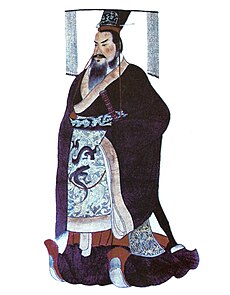 Qin Shi Huang, the first emperor of China (r. 221–210 BC). Mid 19th century depiction Qin Shi Huang, the first emperor of China (r. 221–210 BC). Mid 19th century depiction | |
| Details | |
| Style | His Imperial Majesty (陛下; Bìxià) |
| First monarch | Qin Shi Huang |
| Last monarch | Puyi |
| Formation | 221 BC (2245–2246 years ago) |
| Abolition | 12 February 1912 (112 years ago) |
Throughout Chinese history, "Emperor" (Chinese: 皇帝; pinyin: Huángdì) was the superlative title held by the monarchs who ruled various imperial dynasties or Chinese empires. In traditional Chinese political theory, the emperor was the "Son of Heaven", an autocrat with the divine mandate right to rule all under Heaven. Emperors were worshiped posthumously under an imperial cult. The lineage of emperors descended from a paternal family line constituted a dynasty, and succession in most cases theoretically followed agnatic primogeniture. The emperor of China was an absolute monarch.
During the Han dynasty, Confucianism gained sanction as the official political theory. The absolute authority of the emperor came with a variety of governing duties and moral obligations; failure to uphold these was thought to remove the dynasty's Mandate of Heaven and to justify its overthrow. In practice, emperors sometimes avoided the strict rules of succession and dynasties' purported "failures" were detailed in official histories written by their successful replacements or even later dynasties. The power of the emperor was also limited by the imperial bureaucracy, which was staffed by scholar-officials, and eunuchs during some dynasties. An emperor was also constrained by filial obligations to his ancestors' policies and dynastic traditions, such as those first detailed in the Ming-era Huang-Ming Zuxun (Ancestral Instructions).
Origin and history
See also: Chinese sovereign
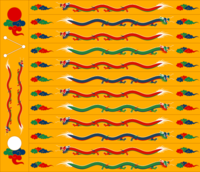
 The Great Chang banner (大常/太常), also known as Banner of Celestial Bodies (辰旒), the highest ranking banner reserved for monarchs per Rites of Zhou.
The Great Chang banner (大常/太常), also known as Banner of Celestial Bodies (辰旒), the highest ranking banner reserved for monarchs per Rites of Zhou.
During the Western Zhou dynasty (c. 1046 BC – 771 BC), Chinese vassal rulers with power over their particular fiefdoms served a strong central monarch. Following a brutal succession crisis and relocation of the royal capital, the power of the Zhou kings (王; wáng) waned, and during the Eastern Zhou period, the regional lords overshadowed the king and began to usurp that title for themselves. In 221 BC, after the King of Qin completed the conquest of the various kingdoms of the Warring States period, he adopted a new title to reflect his prestige as a ruler greater than the rulers before him. He called himself "Shi Huangdi", or the 'First Emperor'. Before this, Huang (皇 'august', 'sovereign') was most commonly seen as a reverential epithet for a deceased ancestor, and Di (帝, OC:*tˤeks) was an apical ancestor, originally referring to the deified ancestors of the Shang kings. In the 3rd century BC, the two titles had not previously been used together. The emperor of China, like the Zhou kings before him, and the Shang kings before them, was most commonly referred to as Tianzi (天子 'Son of Heaven'), who was divinely appointed to rule. The appellation Huangdi carried similar shades of meaning. Alternate English translations of the word include "The August Ancestor", "The Holy Ruler", or "The Divine Lord". On that account, some modern scholars translate the title as "thearch".
On occasion, the father of the ascended emperor was still alive. Such an emperor was titled as the Taishang Huang ('grand imperial sire'). The practice was initiated by Qin Shi Huang, who gave the title as a posthumous name to his own father, as was already common for monarchs of any stratum of power. Liu Bang, who established the Han dynasty, was the first to become emperor while his father yet lived. It was said he granted the title during his father's life because he would not be done obeisance to by his own father, a commoner.
Owing to political fragmentation, over the centuries, it has not been uncommon to have numerous claimants to the title of "Son of Heaven". The Chinese political concept of the Mandate of Heaven essentially legitimized those claimants who emerged victorious. The proper list was considered those made by the official dynastic histories; the compilation of a history of the preceding dynasty was considered one of the hallmarks of legitimacy, along with symbols such as the Nine Ding or the Heirloom Seal of the Realm. As with the First Emperor, it remained very common to grant posthumous titles to the ancestors of the victors.
The Yuan and Qing dynasties were founded by successful invaders of different ethnic groups. As part of their rule over China, they also went through the culturally appropriate rituals of formally declaring a new dynasty and taking on the Chinese title of Huangdi, in addition to the titles of their respective people, especially in the case of the Yuan dynasty. Thus, Kublai Khan was simultaneously khagan of the Mongols and emperor of China.
End of the imperial system
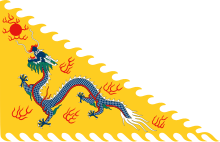
In 1911, the title of Prime Minister of the Imperial Cabinet was created to rule alongside the emperor, as part of an attempt to turn China into a constitutional monarchy.
Puyi, who had reigned as the Xuantong Emperor, abdicated on 12 February 1912, ending the Qing dynasty as well as the imperial tradition altogether, after more than 2100 years. Yuan Shikai, former President of the Republic of China, attempted to restore dynastic rule with himself as the Hongxian Emperor, however he abdicated the throne on 22 March 1916 after only 83 days. Puyi was briefly restored for 12 days during a coup in 1917 but was overthrown again shortly after. Although permitted to remain in the palace, he absconded to the Japanese concession in Tianjin in 1924. In 1934 he was installed as emperor of Manchukuo, a Japanese puppet state. In 1945, he was captured by the Red Army as a prisoner of war, where he was held in the Siberian city of Chita. In 1950, he was extradited to China and imprisoned in Fushun War Criminals Management Centre. He would be formally pardoned and released in 1959, working in a repair shop and as a researcher of literature and history until his death in 1967.
The current head of the House of Aisin-Gioro and hypothetical claimant to the throne is Jin Yuzhang. He has worked for various local councils on China, and has no interest in the restoration of monarchy.
Enumeration
Traditional political theory holds that there can only be one legitimate Son of Heaven at any given time. However, identifying the "legitimate" emperor during times of division is not always uncontroversial, and therefore the exact number of legitimate emperors depends on where one stands on a number of succession disputes. The two most notable such controversies are whether Cao Wei or Shu Han had legitimacy during the Three Kingdoms, and at what point the Song dynasty ceased to be the legitimate dynasty in favor of the Yuan dynasty. The Qing view, reported to Europe by the Jesuits, was that there had been 150 emperors from the First Emperor to the Kangxi Emperor. Adding the eight uncontroversial emperors that followed the Kangxi Emperor would give a grand total of 158 emperors from the First Emperor to Puyi.
By one count, from the Qin dynasty to the Qing dynasty, there were a total 557 individuals who at one point or another claimed the title of Emperor, including several simultaneous claimants at various times. Some, such as Li Zicheng, Huang Chao, and Yuan Shu, declared themselves the emperors, Son of Heaven and founded their own empires as a rival government to challenge the legitimacy of and overthrow the existing emperor. Among the most famous emperors were Qin Shi Huang of the Qin dynasty, emperors Gaozu, Han Wudi as well as Guangwu of the Han, Emperor Taizong of Tang of the Tang, the Hongwu Emperor and Yongle Emperor of the Ming, and the Kangxi Emperor of the Qing.
Power
The emperor's words were considered sacred edicts (圣旨; 聖旨), and his written proclamations were called 'directives from above' (上谕; 上諭). In theory, the emperor's orders were to be obeyed immediately. He was elevated above all commoners, nobility and members of the Imperial family. Addresses to the emperor were always to be formal and self-deprecatory, even by the closest of family members.
In practice, however, the power of the emperor varied between different emperors and different dynasties. Generally, in the Chinese dynastic cycle, emperors founding a dynasty usually consolidated the empire through comparative autocracy—examples include Qin Shi Huang, emperors Gaozu and Guangwu of Han, Emperor Taizong of Tang, Kublai Khan of the Yuan, and the Kangxi Emperor of the Qing.
The usual method for widespread geographic power consolidation was to involve the whole family. From generation to generation, the bonds weakened between the branches of family established as local rulers in different areas. After a sufficient period of time, their loyalty could no longer be assured, and the taxes they collected sapped the imperial coffers. This led to situations like the reign of Emperor Wu of Han, who disenfranchised and annihilated the nobilities of virtually all imperial relatives whose forebears had been enfeoffed by his own ancestor, Gaozu.
Apart from a few very energetic monarchs, the emperor usually delegated the majority of decision making to the civil bureaucracy (chiefly the chancellery and the Central Secretariat), the military, and in some periods the censorate. Paranoid emperors, like Emperor Wu of Han and the Ming's Hongwu Emperor, would cycle through high government officials rapidly, or simply leave top-ranking posts vacant, such that no one could threaten their power. During other reigns, certain officials in the civil bureaucracy wielded more power than the emperor himself.
The emperor's position, unless deposed in a rebellion, was always hereditary, usually by agnatic primogeniture. As a result, many emperors ascended the throne while still children. During minority reigns, the Empress Dowager, the emperor's mother, would usually possess significant political power, along with the male members of her birth family. In fact, the vast majority of female rulers throughout Chinese Imperial history came to power by ruling as regents on behalf of their sons; prominent examples include Empress Lü Zhi of the Han, as well as the empress dowagers Cixi and Ci'an during the Qing, who for a time ruled jointly as co-regents. Where Empresses Dowager were too weak to assume power, or her family too strongly opposed, court officials often seized control. Court eunuchs had a significant role in the power structure, as emperors often relied on a few of them as confidants, which gave them access to many court documents. In a few places, eunuchs wielded vast power; one of the most powerful eunuchs in Chinese history was Wei Zhongxian during the Ming. Occasionally, other nobles seized power as regents.
The actual area ruled by the emperor of China varied from dynasty to dynasty. In some cases, such as during the Southern Song dynasty, political power in East Asia was effectively split among several governments; nonetheless, the political fiction that there was but one ruler was maintained.
Heredity and succession
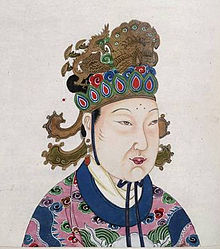
The title of emperor was hereditary, traditionally passed on from father to son in each dynasty. There are also instances where the throne is assumed by a younger brother, should the deceased emperor have no male offspring. By convention in most dynasties, the eldest son born to the Empress consort (嫡长子; 嫡長子) succeeded to the throne. In some cases when the empress did not bear any children, the emperor would have a child with another of his many wives (all children of the emperor were said also to be the children of the empress, regardless of birth mother). In some dynasties the succession of the empress' eldest son was disputed, and because many emperors had large numbers of progeny, there were wars of succession between rival sons. In an attempt to resolve after-death disputes, the emperor, while still living, often designated a crown prince (太子). Even such a clear designation, however, was often thwarted by jealousy and distrust, whether it was the crown prince plotting against the emperor, or brothers plotting against each other. Some emperors, like the Yongzheng Emperor, after abolishing the position of Crown Prince, placed the succession papers in a sealed box, only to be opened and announced after his death.
Unlike, for example, the Japanese monarchy, Chinese political theory allowed for a change in the ruling house. This was based on the concept of the "Mandate of Heaven". The theory behind this was that the Chinese emperor acted as the "Son of Heaven" and held a mandate to rule over everyone else in the world; but only as long as he served the people well. If the quality of rule became questionable because of repeated natural disasters such as flood or famine, or for other reasons, then rebellion was justified. This important concept legitimized the dynastic cycle or the change of dynasties. This principle made it possible even for peasants to found new dynasties, as happened with the Han and Ming dynasties, and for the establishment of conquest dynasties such as the Mongol-led Yuan dynasty and Manchu-led Qing dynasty. It was moral integrity and benevolent leadership that determined the holder of the "Mandate of Heaven".
There has been only one lawful queen regnant in Chinese history, Wu Zetian, who briefly replaced the Tang dynasty with her own Wu Zhou dynasty. Many women, however, did become de facto leaders, usually as Empress Dowager. Prominent examples include Empress Dowager Lü of the Han, Empress Liu of the Song, and Empress Dowager Cixi of the Qing.
Styles, names and forms of address
Further information: Chinese sovereignAs the emperor had, by law, an absolute position not to be challenged by anyone else, his subjects were to show the utmost respect in his presence, whether in direct conversation or otherwise. When approaching the imperial throne, one was expected to kowtow before the emperor. In a conversation with the emperor, it was considered a crime to compare oneself to the emperor in any way. It was taboo to refer to the emperor by his given name, even for the emperor's own mother, who instead was to use Huangdi (皇帝), or simply Er (儿; 兒 'son', for a male emperor). The given names of all the emperor's deceased male ancestors were forbidden from being written, and were avoided (避諱) by the use of synonyms, homophones, or leaving out the final stroke of the taboo character. This linguistic feature can sometimes be used to date historical texts, by noting which words in parallel texts are altered.
The emperor was never to be addressed as you. Instead, one used Bixia (陛下 'bottom of the steps'), corresponding to "Your Imperial Majesty" and originally referring to his attendants, Huangshang (皇上 'imperial highness', Shengshang (圣上; 聖上 'holy highness') or Tianzi (天子 'Son of Heaven'). The emperor was also alluded to indirectly through reference to the imperial dragon symbology. Servants often addressed the emperor as Wansuiye (万岁爷; 萬歲爺 'lord of ten thousand years'). The emperor referred to himself as zhen (朕), the original Chinese first-person singular pronoun arrogated by Qin Shi Huang, functioning as an equivalent to the royal we. In front of subjects, the emperor may also refer to themselves self-deprecatingly as Guaren (寡人 'the morally-deficient one') or Gu (孤 'lonely one').
In contrast to the Western convention of using a regnal or personal name (e.g. George V) to refer to a sovereign, the emperor was referred to in the third person simply as Huangdi Bixia (皇帝陛下 'His Majesty the Emperor') or Dangjin Huangshang (当今皇上; 當今皇上 'present emperor above'). Under the Qing, the emperor was usually styled 'His Imperial Majesty the Emperor of the Great Qing Dynasty, Son of Heaven, Lord of Ten Thousand Years', though this varied considerably. In historical texts, the present emperor was almost universally referred to as Shang (上).
Generally, emperors also ruled with an era name (年号; 年號; nián hào). Since the adoption of era names by Emperor Wu of Han and up until the Ming dynasty, the sovereign conventionally changed the era name semi-regularly during his reign. During the Ming and Qing dynasties, emperors simply chose one era name for their entire reign, and people often referred to past emperors with that title. In earlier dynasties, the emperors were known with a temple name given after their death. Most emperors were also given a posthumous name which was sometimes combined with the temple name (e.g. Emperor Shengzu Ren 圣祖仁皇帝; 聖祖仁皇帝 for the Kangxi Emperor). The passing of an emperor was referred to as Jiabeng (驾崩; 駕崩 'collapse of the imperial chariot') and an emperor that had just died was referred to as Daixing Huangdi (大行皇帝 'the emperor of the great journey').
Consorts and children
In Imperial China, child marriage was the norm. The imperial family was made up of the emperor and the empress (皇后) as the primary consort and Mother of the Nation (国母; 國母). In addition, the emperor would typically have several other consorts and concubines (嫔妃; 嬪妃), ranked by importance into a harem, in which the Empress was supreme. Every dynasty had its set of rules regarding the numerical composition of the harem. During the Qing dynasty, for example, imperial convention dictated that at any given time there should be one Empress, one Imperial Noble Consort, two Noble Consort, four Consort and six Concubine, plus an unlimited number of Noble Lady, First Class Attendant and Second Class Attendant. Although the emperor had the highest status by law, by tradition and precedent the empress dowager (皇太后) usually received the greatest respect in the palace and was the decision maker in most family affairs. At times, especially when a young emperor was on the throne, she was the de facto ruler. The emperor's children, the princes (皇子) and princesses (公主), were often referred to by their order of birth—e.g. Eldest Prince or Third Princess. Princes were often given titles of peerage once they reached adulthood. The emperor's brothers and uncles served in court by law, and held equal status with other court officials (子). The emperor was always elevated above all others despite any chronological or generational superiority.
Ethnicity
See also: Conquest dynasty and Ethnic groups in Chinese historyRecent scholarship is wary of applying present-day ethnic categories to historical situations. Most Chinese emperors have been considered members of the Han ethnicity, but there were also many Chinese emperors who were of non-Han ethnic origins. The most successful of these were the Khitans of the Liao dynasty, the Jurchens of the Jin dynasty (1115–1234), who later ruled the Qing dynasty as the Manchus, and the Mongols of the Yuan dynasty. The orthodox historical view sees these as dynasties as sinicized polities as they adopted Han culture, claimed the Mandate of Heaven, and performed the traditional imperial obligations such as annual sacrifices to Heaven for rain and prosperity. The revisionist New Qing History school, however, argues that the interaction between politics and ethnicity was far more complex and that elements of these dynasties differed from and altered "native Chinese" traditions concerning imperial rule.
Gallery
Mythical
Qin, Han, Xin and Three Kingdoms
-
 Qin Shihuang
Qin Shihuang
-
 Emperor Gaozu of Han (256 –195 BC)
Emperor Gaozu of Han (256 –195 BC)
-
 Emperor Wen of Han (202 –157 BC)
Emperor Wen of Han (202 –157 BC)
-
 Emperor Jing of Han (188 BC –141 BC)
Emperor Jing of Han (188 BC –141 BC)
-
 Emperor Wu of Han (156 –87 BC)
Emperor Wu of Han (156 –87 BC)
-
 Emperor Zhao of Han (94 –74 BC)
Emperor Zhao of Han (94 –74 BC)
-
 Emperor Xuan of Han (91 –49 BC)
Emperor Xuan of Han (91 –49 BC)
-
 Emperor Yuan of Han (75 –33 BC)
Emperor Yuan of Han (75 –33 BC)
-
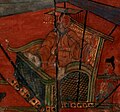 Emperor Cheng of Han (51 –7 BC)
Emperor Cheng of Han (51 –7 BC)
-
 Emperor Ai of Han (27 –1 BC)
Emperor Ai of Han (27 –1 BC)
-
 Emperor Guangwu of Han (5 BC–57 AD)
Emperor Guangwu of Han (5 BC–57 AD)
-
 Emperor Ming of Han (28–75)
Emperor Ming of Han (28–75)
-
 Emperor Zhang of Han (56–88)
Emperor Zhang of Han (56–88)
-
 Emperor Xian of Han (181–234)
Emperor Xian of Han (181–234)
-
 Emperor Wen of Wei (187–226)
Emperor Wen of Wei (187–226)
-
 Emperor Da of Eastern Wu (182–252)
Emperor Da of Eastern Wu (182–252)
-
 Emperor Zhaolie of Shu Han (162–223)
Emperor Zhaolie of Shu Han (162–223)
-
 Emperor He of Han (79 – 13 February 106)
Emperor He of Han (79 – 13 February 106)
-
 Emperor Mo of Sun Wu (243 – January or February 284)
Emperor Mo of Sun Wu (243 – January or February 284)
-
 King Wushun of Huaiyang (died 25)
King Wushun of Huaiyang (died 25)
-
 Wang Mang (45 BCE-23 CE)
Wang Mang (45 BCE-23 CE)
-
 Liu Shan (207-271)
Liu Shan (207-271)
Jin and Northern and Southern dynasties
-
 Emperor Wu of Jin (236–290)
Emperor Wu of Jin (236–290)
-
 Emperor Hui of Jin (259/260-307)
Emperor Hui of Jin (259/260-307)
-
 Emperor Yuan of Eastern Jin (276-323)
Emperor Yuan of Eastern Jin (276-323)
-
 Emperor Ming of Jin (299-325)
Emperor Ming of Jin (299-325)
-
 Emperor An of Jin (382-419)
Emperor An of Jin (382-419)
-
 Emperor Wu of Liu Song (363–422)
Emperor Wu of Liu Song (363–422)
-
 Emperor Wen of Liu Song (407–453)
Emperor Wen of Liu Song (407–453)
-
 Emperor Gao of Southern Qi (427–482)
Emperor Gao of Southern Qi (427–482)
-
 Emperor Wu of Liang (464–549)
Emperor Wu of Liang (464–549)
-
 Emperor Wu of Chen (503–559)
Emperor Wu of Chen (503–559)
-
 Emperor Xuan of Chen (530–582)
Emperor Xuan of Chen (530–582)
-
 Emperor Wen of Chen (522–566)
Emperor Wen of Chen (522–566)
-
 Emperor Fei of Chen (554–570)
Emperor Fei of Chen (554–570)
-
 Emperor Houzhu of Chen (553–604)
Emperor Houzhu of Chen (553–604)
-
 Emperor Wenxuan of Northern Qi (526–559)
Emperor Wenxuan of Northern Qi (526–559)
-
 Emperor Wu of Northern Zhou (543–578)
Emperor Wu of Northern Zhou (543–578)
-
 Emperor Xiaowu of Song(19 September 430 – 12 July 464)
Emperor Xiaowu of Song(19 September 430 – 12 July 464)
-
 Emperor Daowu of Northern Wei(371–409)
Emperor Daowu of Northern Wei(371–409)
-
 Emperor Xiaozhuang of Northern Wei(507-531)
Emperor Xiaozhuang of Northern Wei(507-531)
-
Emperor Wencheng of Northern Wei(July or August 440 – 20 June 465)
-
 Emperor Xiaowen of Northern Wei(October 13, 467 – April 26, 499)
Emperor Xiaowen of Northern Wei(October 13, 467 – April 26, 499)
-
 Emperor Mingyuan of Northern Wei(392 – 24 December 423)
Emperor Mingyuan of Northern Wei(392 – 24 December 423)
-
 Emperor Min of Jin(300-318)
Emperor Min of Jin(300-318)
-
 Emperor Huai of Jin(284-313)
Emperor Huai of Jin(284-313)
Sui dynasty
-
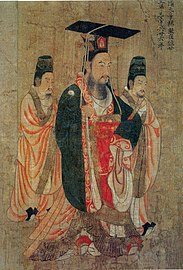 Emperor Wen of Sui (541–604)
Emperor Wen of Sui (541–604)
-
 Emperor Yang of Sui (569–618)
Emperor Yang of Sui (569–618)
Tang dynasty
-
 Emperor Gaozu of Tang (566–635)
Emperor Gaozu of Tang (566–635)
-
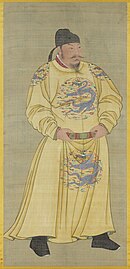 Emperor Taizong of Tang (598–649)
Emperor Taizong of Tang (598–649)
-
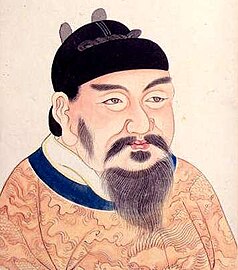 Emperor Gaozong of Tang (628–683)
Emperor Gaozong of Tang (628–683)
-
Empress Wu Zetian of the Zhou dynasty (690–705)
-
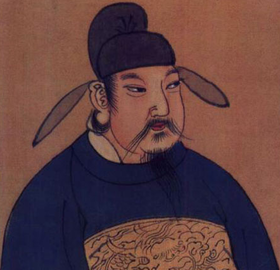 Emperor Zhongzong of Tang (656–710)
Emperor Zhongzong of Tang (656–710)
-
 Emperor Ruizong of Tang (662–716)
Emperor Ruizong of Tang (662–716)
-
 Emperor Xuanzong of Tang (685–762)
Emperor Xuanzong of Tang (685–762)
-
 Emperor Shengwu of Yan (703–757)
Emperor Shengwu of Yan (703–757)
-
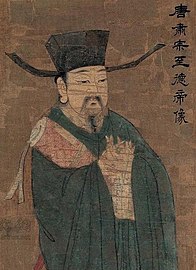 Emperor Suzong of Tang (711–762)
Emperor Suzong of Tang (711–762)
-
 Emperor Daizong of Tang (727–779)
Emperor Daizong of Tang (727–779)
-
 Emperor Dezong of Tang (742–805)
Emperor Dezong of Tang (742–805)
-
 Emperor Xianzong of Tang (778–820)
Emperor Xianzong of Tang (778–820)
-
 Emperor Muzong of Tang (795–824)
Emperor Muzong of Tang (795–824)
-
 Emperor Jingzong of Tang (809–827)
Emperor Jingzong of Tang (809–827)
-
 Emperor Wenzong of Tang (809–840)
Emperor Wenzong of Tang (809–840)
-
 Emperor Wuzong of Tang (814–846)
Emperor Wuzong of Tang (814–846)
-
 Emperor Xuanzong of Tang (810–859)
Emperor Xuanzong of Tang (810–859)
-
 Emperor Yizong of Tang (833–873)
Emperor Yizong of Tang (833–873)
-
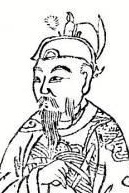 Emperor Xizong of Tang (862–888)
Emperor Xizong of Tang (862–888)
-
 Emperor Zhaozong of Tang (867–904)
Emperor Zhaozong of Tang (867–904)
Five dynasties
-
 Emperor Taizu of Later Liang
Emperor Taizu of Later Liang
-
 Emperor Zhuangzong of Later Tang
Emperor Zhuangzong of Later Tang
-
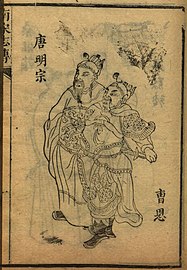 Emperor Mingzong of Later Tang
Emperor Mingzong of Later Tang
-
 Emperor Gaozu of Later Jin
Emperor Gaozu of Later Jin
-
 Emperor Gaozu of Later Han
Emperor Gaozu of Later Han
-
 Emperor Taizu of Later Zhou
Emperor Taizu of Later Zhou
-
 Emperor Shizong of Later Zhou
Emperor Shizong of Later Zhou
-
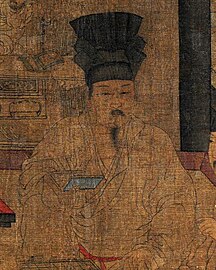 Emperor Yuanzong of Southern Tang
Emperor Yuanzong of Southern Tang
-
 Wang Jian (Former Shu) (847 – July 11, 918)
Wang Jian (Former Shu) (847 – July 11, 918)
-
 Wang Yanzheng (died 951)
Wang Yanzheng (died 951)
Northern Song dynasty
-
 Zhao Hongyin, posthumously made emperor by his son, the first emperor of the Song dynasty
Zhao Hongyin, posthumously made emperor by his son, the first emperor of the Song dynasty
-
 Emperor Taizu of Song (927–976)
Emperor Taizu of Song (927–976)
-
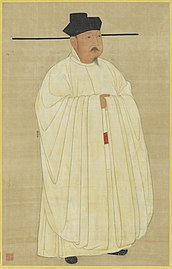 Emperor Taizong of Song (939–997)
Emperor Taizong of Song (939–997)
-
 Emperor Zhenzong of Song (968–1022)
Emperor Zhenzong of Song (968–1022)
-
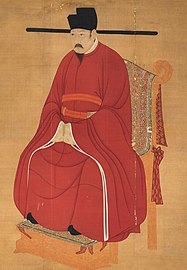 Emperor Renzong of Song (1010–1063)
Emperor Renzong of Song (1010–1063)
-
 Emperor Yingzong of Song (1032–1067)
Emperor Yingzong of Song (1032–1067)
-
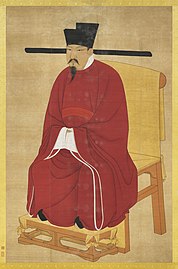 Emperor Shenzong of Song (1048–1085)
Emperor Shenzong of Song (1048–1085)
-
 Emperor Zhezong of Song (1077–1100)
Emperor Zhezong of Song (1077–1100)
-
 Emperor Huizong of Song (1082–1135)
Emperor Huizong of Song (1082–1135)
-
 Emperor Qinzong of Song (1100–1161)
Emperor Qinzong of Song (1100–1161)
Southern Song dynasty
-
 Emperor Gaozong of Song (1104–1187)
Emperor Gaozong of Song (1104–1187)
-
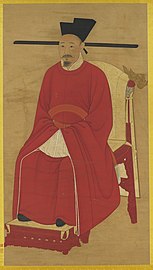 Emperor Xiaozong of Song (1127–1194)
Emperor Xiaozong of Song (1127–1194)
-
 Emperor Guangzong of Song (1147–1200)
Emperor Guangzong of Song (1147–1200)
-
 Emperor Ningzong of Song (1168–1224)
Emperor Ningzong of Song (1168–1224)
-
 Emperor Lizong of Song (1205–1264)
Emperor Lizong of Song (1205–1264)
-
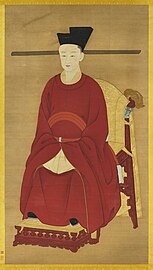 Emperor Duzong of Song (1240–1274)
Emperor Duzong of Song (1240–1274)
-
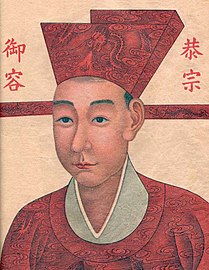 Emperor Gong of Song (1271–1323)
Emperor Gong of Song (1271–1323)
-
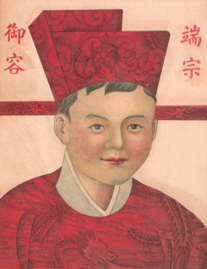 Emperor Duanzong (1270–1278)
Emperor Duanzong (1270–1278)
-
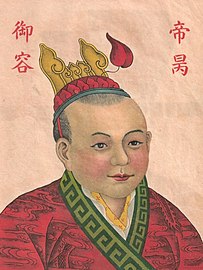 Zhao Bing (1272–1279)
Zhao Bing (1272–1279)
Yuan dynasty
-
 Kublai Khan (1215–1294)
Kublai Khan (1215–1294)
-
 Temür Khan (1265–1307)
Temür Khan (1265–1307)
-
 Külüg Khan (1281–1311)
Külüg Khan (1281–1311)
-
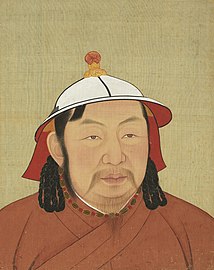 Ayurbarwada Buyantu Khan (1285–1320)
Ayurbarwada Buyantu Khan (1285–1320)
-
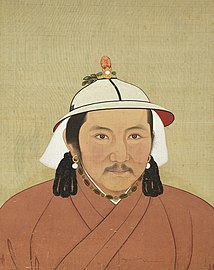 Jayaatu Khan Tugh Temür (1304–1332)
Jayaatu Khan Tugh Temür (1304–1332)
-
 Rinchinbal Khan (1326–1332)
Rinchinbal Khan (1326–1332)
Ming dynasty
-
 Hongwu Emperor
Hongwu Emperor
-
 Jianwen Emperor
Jianwen Emperor
-
 Yongle Emperor
Yongle Emperor
-
 Hongxi Emperor
Hongxi Emperor
-
 Xuande Emperor
Xuande Emperor
-
 Zhengtong Emperor
Zhengtong Emperor
-
 Jingtai Emperor
Jingtai Emperor
-
 Chenghua Emperor
Chenghua Emperor
-
 Hongzhi Emperor
Hongzhi Emperor
-
 Zhengde Emperor
Zhengde Emperor
-
 Jiajing Emperor
Jiajing Emperor
-
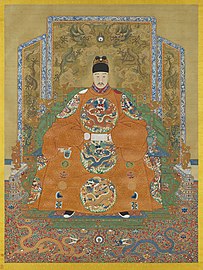 Longqing Emperor
Longqing Emperor
-
 Wanli Emperor
Wanli Emperor
-
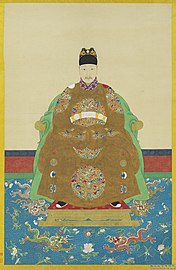 Taichang Emperor
Taichang Emperor
-
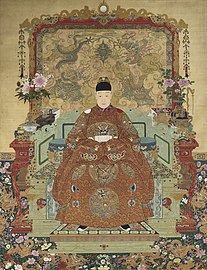 Tianqi Emperor
Tianqi Emperor
Qing dynasty
-
 Shunzhi Emperor
Shunzhi Emperor
-
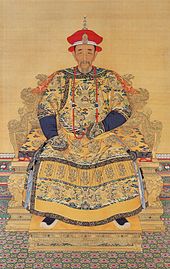 Kangxi Emperor
Kangxi Emperor
-
 Yongzheng Emperor
Yongzheng Emperor
-
 Qianlong Emperor
Qianlong Emperor
-
 Jiaqing Emperor
Jiaqing Emperor
-
Daoguang Emperor
-
 Xianfeng Emperor
Xianfeng Emperor
-
 Tongzhi Emperor
Tongzhi Emperor
-
 Guangxu Emperor
Guangxu Emperor
-
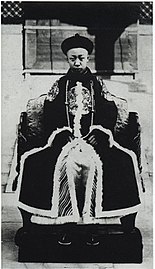 Xuantong Emperor
Xuantong Emperor
Empire of China
-
 Yuan Shikai as the Hongxian Emperor of China (1915–1916)
Yuan Shikai as the Hongxian Emperor of China (1915–1916)
See also
- Chinese emperors family tree
- Tributary system of China
- List of Chinese monarchs
- Dragon Throne
- Taishang Huang – an honorific for a retired emperor
- Celestial Empire
- Chinese Empire
- Khan of Heaven
- Emperor at home, king abroad
Notes
- *ɢʷaŋ,
- *ɢʷˤaŋ
- Huang (皇) and Di (帝) were also terms applied to the Three Sovereigns and Five Emperors, mythical godly rulers and culture heroes credited with feats like ordering the sky and forming the first humans out of clay, as well as the invention of agriculture, clothing, astrology, music, etc.
- Yuan Shikai was installed as Emperor in the short-lived Empire of China in December 1915, but abdicated after 83 days. Puyi was reinstated as Emperor for 12 days in 1917 in a failed coup attempt.
References
- Dillon, Michael, ed. (2017). Encyclopedia of Chinese History. Routledge. p. 182. ISBN 978-0-415-42699-2.
- "German prince's coup attempt recalls China's last emperor Aisin-Gioro Puyi, who was reinstated and removed, twice". South China Morning Post. Retrieved 19 September 2024.
- ^ "The legacy of Yuan Shikai, China's disastrous first president". China Project. Retrieved 19 September 2024.
- "25", 通典,
顏師古曰:「太常者,王之旌也,畫日月焉。王者有大事則建以行,禮官主奉持之,故曰奉常,後改為太,尊大之義也。」
- "春官宗伯—司常之職", 周禮,
旗物:王建大常,諸侯建旗,孤卿建旃,大夫、士建物,師都建旗,州里建旟,縣鄙建旐,道車載旞,斿車載旌。」
- Baxter, William & al. Baxter–Sagart Old Chinese Reconstruction Archived September 27, 2013, at the Wayback Machine. 2011. Accessed 22 Dec 2013.
- ^ Nadeau, Randall L. The Wiley-Blackwell Companion to Chinese Religions, pp. 54 ff. John Wiley & Sons (Chichester), 2012. Accessed 22 December 2013.
- Harrison, Thomas; Blanshard, Alastair; Bryce, Trevor; Coningham, Robin; Jenner, W. J. F.; Kaizer, Ted; Llewellen-Jones, Lloyd; Manley, Bill; Manuel, Mark (2009). Harrison, Thomas (ed.). The Great Empires of the Ancient World. Los Angeles: Getty Publications. p. 254. ISBN 978-0-89236-987-4.
- Sima Qian, Records of the Grand Historian, "Gaozu's Basic Annals", 61
- Sima Qian (author) & Burton Watson (translator) (1971). Records of the Grand Historian of China "Volume I: The Early Years of the Han dynasty from 209 to 141 B.C. Part III: The Victor - The Basic Annals of Emperor Kao-tsu (Shih-chi 8)" p. 108-109.
- "Puyi". Britannica. Retrieved 19 September 2024.
- "Just call me Jin, says the man who would be emperor". Sydney Morning Herald. Nine Entertainment. 27 November 2004. Retrieved 2 October 2022.
- Wilkinson, Endymion. (2018). Chinese History, a New Manual. Pp 9-8, 684
- Intorcetta, Prospero. (1687). Confucius Sinarum Philosophus
- Barmé, Geremie (2008). The Forbidden City. Harvard University Press. p. 594. ISBN 978-0-674-02779-4.
- "看版圖學中國歷史", p.5, Publisher: Chung Hwa Book Company, Year: 2006, Author: 陸運高, ISBN 962-8885-12-X.
- Nylan, Michael (2016). "Mapping Time in the Shiji and Hanshu Tables". East Asian Science, Technology, and Medicine. 43 (43). Brill: 61–122. doi:10.1163/26669323-04301004. JSTOR 90006244. S2CID 171943719.
- Hucker, Charles O. (1985). A Dictionary of Official Titles in Imperial China. Stanford: Stanford University Press. pp. 4–102. ISBN 978-957-638-285-7.
- Saito, O. (1996). "Historical demography: achievements and prospects". Population Studies. 50 (3): 537–553. doi:10.1080/0032472031000149606. PMID 11618380.
- Zhao, Z. (1997). "Demographic systems in historic China: some new findings from recent research". Journal of the Australian Population Association. 14 (2): 201–232. Bibcode:1997JAuPA..14..201Z. doi:10.1007/BF03029340. PMID 12322104. S2CID 8006287.
- Sinicization vs. Manchuness: The Success of Manchu Rule
Further reading
- Paludan, Ann (1998). Chronicle of the Chinese Emperors: The Reign-by-Reign Record of the Rulers of Imperial China. New York: Thames and Hudson. ISBN 0-500-05090-2.
External links
| Government of Imperial China | |||||
|---|---|---|---|---|---|
| Nobility | |||||
| Offices | |||||
| Institutions | |||||
| Early Imperial | |||||
| Middle Imperial |
| ||||
| Late Imperial |
| ||||
| Imperial guards | |||||
| Dynasties | |||||


